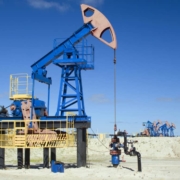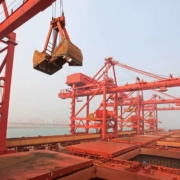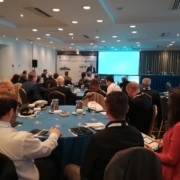How OPEC’s coronavirus cuts affect ocean shipping
The market expected a new coronavirus-induced 1 million-barrel-per-day (b/d) production cut from OPEC+, the coalition of OPEC and participating non-OPEC nations. What it got on Thursday was a much bigger proposed cut of 1.5 million b/d.
Underscoring the severity of the demand problem, crude prices fell by 2% on Thursday despite the OPEC news.
How do escalating crude-oil production cuts affect ocean shipping? It depends on the sector.
Crude-tanker demand
There are those who believe OPEC cuts are a plus for crude tankers because such reductions are replaced by U.S. exports to Asia, which travel longer distances and soak up more capacity. That is the minority view, however.
“The global crude-tanker market is around 40 million b/d, so the impact of a 1.5 million-b/d cut — 4% of seaborne volumes — is especially challenging for crude-tanker names,” said Stifel analyst Ben Nolan. “The OPEC cut is a negative,” echoed Jefferies analyst Randy Giveans.
U.S. crude exports are indeed very strong. According to data from the Energy Information Administration (EIA), the U.S. exported a record 3 million b/d in full-year 2019 — 3.7 million b/d in the month of December.
The optimistic view on OPEC cuts assumes that U.S. exports shipped aboard VLCCs (very large crude carriers, capable of carrying 2 million barrels of crude oil) from the Gulf of Mexico to Asia via the Cape of Good Hope replace VLCCs loading in the Middle East.
However, the EIA data shows that much of the incremental export growth is going to Europe. If OPEC cuts offset demand declines in Asia and U.S. exports flow more to Europe than to Asia, that’s not positive for crude-tanker demand.
During the call with analysts on Wednesday, International Seaways (NYSE: INSW) CEO Lois Zabrocky confirmed that “a lot [of U.S. Gulf crude exports] is going out on Aframaxes and Suezmaxes at the moment.” Aframaxes carry 750,000 barrels and Suezmaxes carry 1 million barrels; these vessel types are largely used for shorter-haul exports to Europe and Latin America.
Another point was raised by Frode Mørkedal, managing director of research at Clarksons Platou Securities. He acknowledged that “OPEC cuts are likely negative on the margin,” but he noted that if there were no cuts, and oil prices fell even more steeply due to coronavirus, it would hit U.S. shale producers and curtail exports. “The bottom line is … the potential slowdown in U.S. crude output if prices were to collapse would be much worse for tankers [than OPEC+ cuts].”
Container liner costs
To the extent OPEC+ is able to stabilize crude oil prices, it’s a negative for container lines.
Container carriers have been contending with higher fuel costs due to the IMO 2020 rule, which requires vessels without exhaust-gas scrubbers to switch from cheaper 3.5% sulfur heavy fuel oil (HFO) to more expensive 0.5% sulfur fuel known as very low sulfur fuel oil (VLSFO).
The large majority of container ships do not yet have scrubbers installed, and those scheduled to install them are seeing timetables pushed back as a result of coronavirus-induced delays at Chinese yards.
When Maersk reported its quarterly results on Feb. 20, the company’s CEO, Soren Skou, noted that the company had been able to pass along the costs of IMO 2020 implementation to cargo shippers through both contracts and spot pricing. But he also conceded that the market was much weaker after Chinese New Year (due to the coronavirus), so it remains to be seen whether the costs could continue to be passed along.
Ship & Bunker estimated that as of Wednesday, the global average for VLSFO was $497 per ton. A year prior, HFO was priced at $471.50, equating to a year-over-year IMO 2020-related cost increase of 5%.
That is minuscule versus what it was just a few months ago. According to Ship & Bunker pricing data, the global average price of VLSFO was $686.50 per ton on Jan. 8. A year before, the price of HFO was $417.50, equating to a year-over-year IMO 2020-related cost increase of 64%.
The reason the cost increase slumped from 64% to 5% is that the price of VLSFO (based on the global average) plummeted 28% between Jan. 8 and Wednesday. This coincides with the drop in crude pricing, which has accelerated on coronavirus fears. Over the same period, the price of Brent crude declined 26%.
In other words, the oil price decline has been a huge benefit to container lines on the cost side, by largely removing the IMO 2020 fuel price increase.
If OPEC+ production cuts push the price back up, it would be a negative for container lines. The good news for container lines is that it does not yet appear OPEC+ can increase crude prices. The bad news for container lines is that the cartel’s inability to do so is related to weaker global demand, which will hit the carriers on the revenue side of the equation.
Scrubber-equipped vessels
Ship owners who invested heavily in scrubbers may be rooting for OPEC+ because the sharp decline in the price of VLSFO is having an increasingly negative effect on scrubber economics.
Scrubber economics depends upon the spread between HFO and VLSFO on any given day. The spread implies the “payback period” in which the cost of installing the scrubber is eventually covered. Based on global average prices compiled by Ship & Bunker, that spread was $279 on Jan. 8 and down to half that — $139 — on Wednesday.
This issue was addressed on the Feb. 26 quarterly conference call of Genco Shipping & Trading (NYSE: GNK). The company’s CEO, John Wobensmith, noted that “the spread has certainly weakened, but this is a seasonally slow period and there’s also a slowdown from coronavirus. Once all that’s in our rearview mirror, I expect more demand for VLSFO and for the spreads to push back toward $200. And if the price of oil moves up, the spread will move up as well.”
The question ahead for those who invested millions in fleet scrubber installations is: What if the OPEC+ coalition can’t arrest the slide in crude? What if the price of VLSFO keeps falling and the VLSFO-HFO spread becomes negligible? More FreightWaves/American Shipper articles by Greg Miller
Source: https://www.freightwaves.com/







